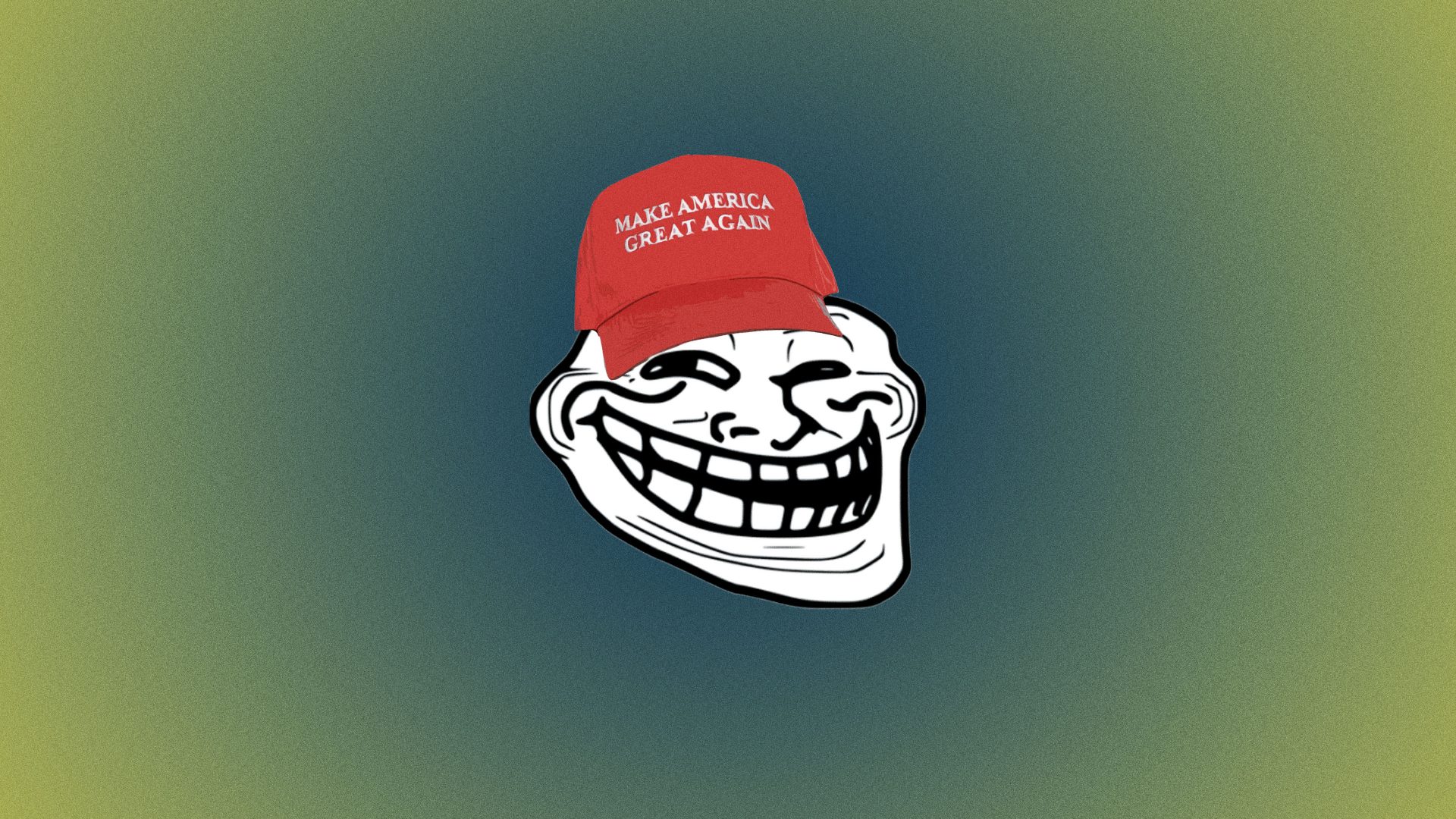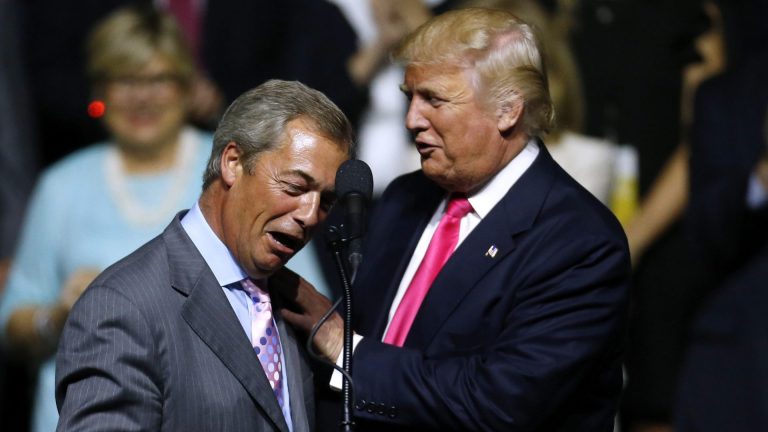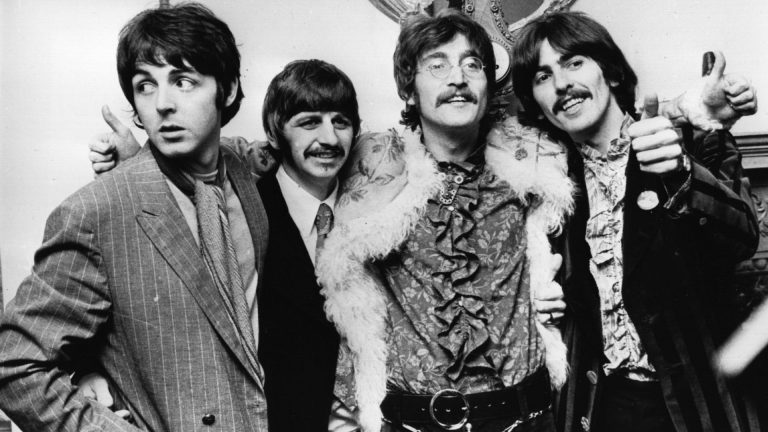“I’ve decided,” the Spectator writer Rod Liddle said in a recent column, “that I would like President Trump to win the next American presidential election.” This is not, he clarifies, because he has engaged with the politics. Liddle is way too cool for that. No: it’s because it will upset people who care, and caring is so lame.
“This is one of the good things about Trump,” Liddle explains: “he unhinges liberals.” The left, he predicts, “will seethe and throw their toys out of the pram if Trump wins.” This is the objective in and of itself. Are you triggered, libs?
This motif is so pat that its reaching the pages of the Spectator makes it notable more for heralding the end of a phenomenon than its beginning. Over the past 10 years I’ve covered trolling and how it has interacted with far right politics, charting how it became a significant driving force in politics. Tediously provocative columns are as old as the printed word, but the particular flavour of sentiment that Liddle echoes evolved on a few hugely influential message-boards in the 2010s.
Something seismic has become observable if you know where to look, something potentially more important than any of the speculative polls showing Trump and Biden in a virtual tie. Which is that the actual trolls, members of the specific digital subculture that powered and underpinned the Trump movement and made it so explosive in 2016, have drifted away. Trump’s 2024 campaign may look dominant in the context of the Republican primary, and in the power he still holds over Republicans in Congress, but in terms of the general election there’s another way of measuring it: the troll primary. And from that perspective, Trump could be in trouble.
Just as the basic unit of biological life is the gene, the basic unit of cultural life is the meme. A piece of information that aims, like a gene does, to reproduce itself. One form it can take is a picture, but it can be anything. In 2016, “Trump ran a campaign whose platform consisted not of policy proposals or thoughtful argumentation, but almost entirely of memes,” argue Whitney Phillips and Ryan Milner in their book You Are Here: A Field Guide for Navigating Polarized Speech, Conspiracy Theories, and Our Polluted Media Landscape. “Memes emerge when resonant ideas spread within and across social collectives. Factual, objective truth isn’t a requisite if the underlying idea connects and compels sharing.”
Everything was packaged and sloganised into byte-sized pieces to spread online. Take “Pizzagate” for example, the bizarre rumour that Hillary Clinton was running a child sex ring out of a pizza restaurant in the suburbs of Washington DC. That story started its memetic life cycle in the imagination of trolls who, crucially, were in on the joke. They spread the story with such persistence that it was elevated to the mainstream, where it filtered into the public consciousness with real-world consequences. In this particular example, someone was taken in by the story enough to actually go to the pizza joint with a gun to “investigate”. Miraculously, no one was killed.
The strategy first emerged in 2014 with a troll-based rumpus that became known as “Gamergate”, when an inchoate group, overwhelmingly white and male, became angered by what they considered the invasion of the gaming space by women and “social justice warriors”. Gamergate went to war with the games industry and journalism and grew exponentially, eventually evolving into what became known as the “alt-right”. This loose confederation of overlapping right wing tribes shared an iconoclastic bent, a take-no-prisoners mindset, and the digital-native skills required to engage in meme warfare.
This is what we mean when we talk about the “culture war” in modern politics: a concerted effort to spread informational nuggets that are designed to provoke anger and division. The alt-right positioned itself against feminism and political correctness, and their success was closely observed by Steve Bannon, later Trump’s chief strategist, whose stroke of genius was understanding the quantum leap they represented in political tactics. He learned their language and courted them brilliantly, cementing them into a rabid activist base for Trump’s 2016 campaign.
The word “trolling” doesn’t actually come from trolls of the kind who hide under bridges in fairy tales. It has the same etymological root as “trawl”, like in fishing. You put out a big net, and see what you can drag in. The ultimate aim is simply to annoy or provoke; it has no ideology of its own. It follows – and this is crucial – what’s funny. Trolling is devil-may-care. Nothing matters, and everything is fair game. Non-cynically believing in something, being earnest enough to get upset, makes someone the best target. Progressives were easy pickings. Calls for things like trigger warnings were reversed and weaponised: triggering people became the objective.
Memes made and shared on places like 4chan were seeded on wider social media sites such as Reddit or Twitter. Often, Trump used his enormous Twitter following to elevate them to the mainstream. From there, they were picked up by right wing media and reached social platforms like Facebook that prioritise content algorithmically by engagement – and nothing powers engagement like anger.
This exploited a huge vulnerability in the media. Once places like Fox News had hold of it, or Trump retweeted it, mainstream outlets couldn’t help but spread it through secondary coverage: it had to be reported that someone was talking about it. This content was often outraged in tone, but that didn’t matter at all. Each jump got the story further from sourcing and closer to the eyeballs of millions of people who lacked the media literacy to parse them.
4chan is a pretty humble-looking website. Visually, it has barely changed in two decades. But for much of that time this has been the engine-room of internet culture. This is where trolling in its digital form was invented and where, arguably, it was perfected. This place was a huge part of what made Trump president in 2016. The shock-troops of the meme war.
To understand how it worked, you need to understand the structure of sites like this. They have two things that make them incredibly powerful engines for the production – perhaps a better metaphor is midwifing – of memes. First, anonymity. On these message-boards, everyone is simply “Anon”. There is zero personal accountability for any given post. You can be anything – your purest self, or an absurd caricature. Second is ephemerality. Threads are kept alive by activity; as people stop replying, they fall down the rankings and quickly drop dead. Once they’re gone, they’re gone. Even the most successful threads only last a few hours, maybe a day.
These things made 4chan a rich primordial ooze, perfect for incubating memetic life. It became greater than the sum of its parts, acting almost like an independent intelligence.
There are multiple boards on 4chan for niche interests like cars, but only two boards really matter. Those are /pol/, the “politically incorrect” board, and /b/, the random board. They have distinct personalities. /Pol/ is, not to put too fine a point on it, pretty much fascist. /B/ is pure anarchy.
The most devastating example of their power, their wildest success, is Qanon – the origins of which I delved into in my podcast Finding Q. Now a vast and ravenous movement based on the conspiracy theory that the world is run by a deep state child-trafficking ring led by Hillary Clinton, Qanon started on 4chan as a troll post and metastasised, radicalising hundreds of thousands of people and influencing millions of votes. Without Qanon, there would have been no January 6 storming of the Capitol in Washington.
In 2016, trolls gleefully supported Trump. He was the funniest outcome. It is difficult to describe what it was like watching this frantic collective operate in real time. Thousands of anonymous posters competed with each other to launch memes furthest into the mainstream zeitgeist. “Guys,” one anon posted on election night 2016 with something approaching awe, “we just memed a president.”
Today, things are drastically different. “Have you ever considered,” one recent post reads, “that he’s actually a total shithead?” The picture accompanying the post is of Trump. “Yes,” is the first response. Another: “Well yeah he’s a politician, what do you expect?” Supporting Trump is no longer funny. The joke has worn thin; the trickster-god has bored of its plaything. “How much prison time do you think he’ll do,” an anon asks. “None. He’ll die before then,” someone responds. “The syphilis is already affecting his motor skills.”
Pro-Trump posts used to be the rule; now they are the exception. These days, it is more often Trump supporters being targeted, and responding with anger – having been successfully trolled.
Trump’s political machine is built on the trolls who underpinned it for almost a decade. But underneath, it has ossified into the thing they hate most: earnestness. There is nothing more contemptuous than a true believer. The “liberal tears” mode of thinking is now the preserve of boomer columnists, and they are the butt of the joke. Progressives have evolved strategies to combat it; the left has become more cynical and aware. No one is getting triggered by Rod Liddle. The real trolls have moved on.
That’s not to say there isn’t real danger. Qanon has a life all of its own now, for example, and will play a big role in this election year. But Democrats can be cautiously optimistic that the Trump campaign, stripped of its memetic firepower, is now probably weaker than current polling suggests.









